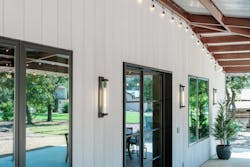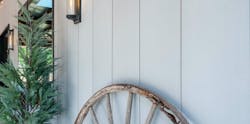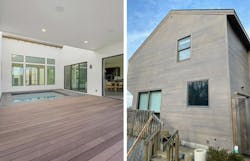The Benefits of Biophilic Design, Without the Economic or Environmental Costs
We hear the term “biophilic design,” and we likely think of buildings with lots of plants, wood, stone, and other natural elements. If biophilic design aims to connect occupants more closely with the natural world to improve their well-being, then buildings can only create those connections with natural, organic materials, right?
Not necessarily, according to a recent report by Modern Mill, a company that creates a wood-alternative building material called Acre.
Urban greenery projects, such as the Bosco Verticale (or Vertical Forest) in Milan, capture much of the attention and conversation around biophilic design, the report notes. But these projects, though visually stunning, tend to be quite costly and challenging to install and maintain, with regular maintenance falling on homeowners or their building associations. As a result, the designs are difficult to scale. “All the urban forest projects now underway will represent only a miniscule fraction of the housing stock in their respective cities,” the report claims.
“Like most people, we recognize all the benefits to our physical and mental well-being when we bring people closer to nature—that’s the premise of biophilic design. But why is that limited to high-end buildings?” says Kim Guimond, chief marketing officer, Modern Mill.
MIMICKING NATURE WITH MANUFACTURED PRODUCTS
The physical and mental benefits of biophilic design can be achieved more economically and sustainably with manufactured products, Modern Mill’s report argues. The report cites research showing that simulated or recorded nature can realize the benefits of actual nature. One study, for instance, compared the restorative effects of 30 minutes spent in a natural environment and in an indoor simulation of that environment, and it concluded that both experiences reduced stress.
Both real and simulated nature taps into our evolutionary need for health and well-being, the report says. The sound of a running stream and the smell of a forest suggest the ready availability of water, food, and shelter.
Likewise, manufactured materials that convey the texture and warmth of wood can provide occupants with a sense of comfort and wellness. Products that successfully mimic nature have to meet certain conditions, however. For one thing, these materials have to look realistic, the report notes. They shouldn’t have obviously repeating patterns but should instead appear and feel like the real thing.
And that’s what Modern Mill’s Acre achieves, Guimond says. Made mostly from rice husks, Acre delivers the biophilic and aesthetic benefits of high-end wood—but for a lower price, Guimond says. “We cost more than pressure-treated wood but less than Ipe, teak, and cedar.” Acre can be used for flooring, decking, siding, trim—taking the place of wood in any application except structural. Lightweight but stiff so it won’t break, Acre can be handled just like wood, no special tools or training required.
Modern Mill opened its factory in 2019 and sold its first shipment of Acre in 2020. This year, Fast Company named Modern Mill the winner of the World Changing Ideas Award in the midsize business category.
More than half of Acre by volume is made with upcycled rice husks from farms in the Southern U.S.—discarded hulls that otherwise would head to landfills. Aside from California, Southern states produce almost all the rice in the U.S., which informed Modern Mill’s Mississippi location. (The U.S. accounts for less than 2% of global rice production but is the world’s fifth largest exporter of rice.)
To create its completely tree-free product, Modern Mill grinds the rice husks and mixes them with PVC and other additives (that are not VOC-emitting materials), then extrudes the resin into sheets that can be cut into boards. Just as each rice husk protects its grain from weather and pests, it does the same when turned into sheets of Acre. In the field, Acre has 15% to 20% less extension and contraction than traditional PVC products. And unlike those PVC products, Acre can be not only painted but also stained.
When replacing exotic hardwoods such as Ipe, one pallet of Acre saves an acre of tropical rainforest. In its first business year, Modern Mill saved the equivalent of about 4,000 acres of tropical rain forest and upcycled over 3,000 tons of rice husks that would have gone to landfills. Even the sawdust created by Modern Mill’s production process goes back into its boards. “We’re never going to take down a tree,” Guimond says.
To read more insights, download the full report below. For more on biophilic design, read it here on Utopia.


